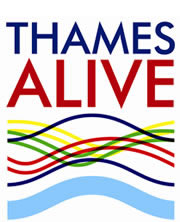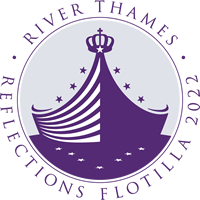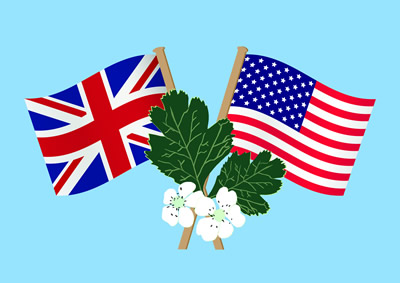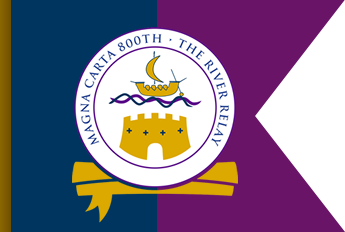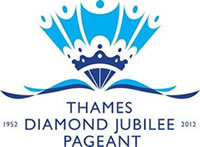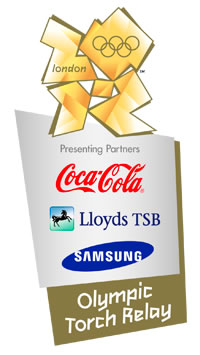The Queen's Row Barge Gloriana
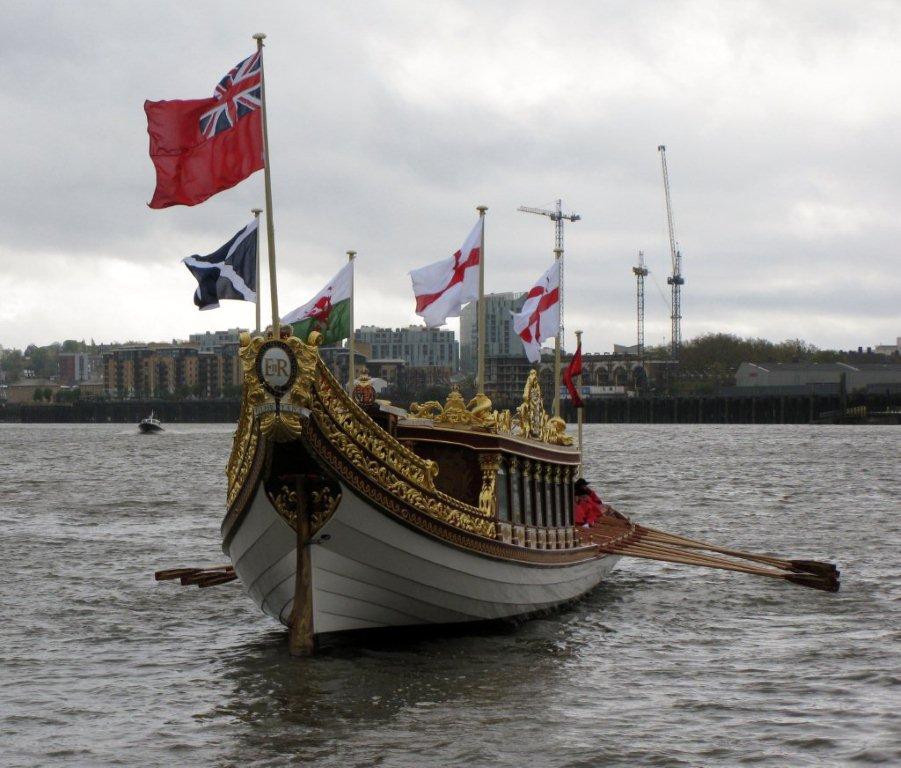
As a celebration of the Queen’s Diamond Jubilee, and to highlight and pay tribute to the role of the River Thames in the history and pageantry of London through the ages, Lord Sterling, with the support of a small syndicate consisting of The Gosling Foundation, Eyal Ofer, Lloyd's Register, and the Weston Foundation, commissioned a Royal Row Barge for Her Majesty the Queen. It echoes those used on royal occasions in the 17th, 18th and 19th centuries. Most importantly, the row barge is the lasting legacy of the Diamond Jubilee. More: PRESS RELEASE: DIAMOND JUBILEE QUEEN'S ROWBARGE »
Thames Alive managed all activities of the Royal Barge between 2012 and 2019 and still retain a close contact with The Gloriana Trust.
View photos of the build and launch of Gloriana
View the Official Website of Gloriana
View News Stories about The Gloriana:
Queen visits her Diamond Jubilee Barge (25 April 2012 telegraph.co.uk)
Queen brightens the gloom as she names Gloriana, the first royal barge to be built in 100 years (25 April 2012 Mail Online)
Royal Barge to enter the Thames (19th April 2012 BBC News)
Royal Barge Gloriana launched on River Thames in London (19 April 2012 BBC News)
Aqua Triumphalis
Thames Alive Chairman Peter Warwick looks at the history of state barges on the Thames and describes how The Queen’s Row Barge Gloriana is the lasting legacy of the Diamond Jubilee.
For me it began with the ceremonial re-enactment of Admiral Lord Nelson’s river borne funeral procession in 2005 – the largest event of its kind on the river for well over one hundred years, which in turn led to the formation of Thames Alive and the promotion of a major river pageant to celebrate The Queen’s Diamond Jubilee. In turn this gave the impetus for The Queen’s Row Barge Gloriana.
Gloriana is the lasting legacy of the Diamond Jubilee. She is a showcase for British rowing, traditional boatbuilding and craftsmanship, and an inspiration for national pride. She bestows a regal presence on the Thames, enhancing the river's special place in the life of both the capital and the country, and will be used to promote the better use of the Thames. Her presence restores to the river an asset that has been absent for well over a hundred years and echoes the origins and traditions of rowing as a sport.
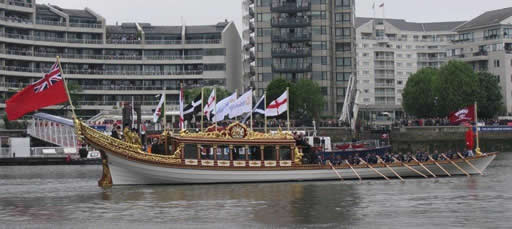
In the words of David Starkey, “As an historian, I’m delighted to see the revival of the great tradition of royal row barges and pageantry on the River Thames. But this beautiful wooden vessel doesn’t only look to the part. It will provide a focal point for the celebration of the Jubilee and also promises to be a lasting asset to the charities and educational organisations using the river in their work”.
As such, Gloriana places a particular emphasis on inspiring and encouraging young people of all backgrounds and abilities to discover rowing’s remarkable characteristics of teamwork and fellowship. She will also be used to support The Prince’s Trust, royal supported and other charities, and will also be present at major river and rowing event, such as Henley Royal Regatta, so that the public has frequent opportunities to see her close to.
The design and build of the Queen’s Row Barge utilises structures and techniques that have changed little since the clinker built (with the planks overlapping) long-boats of the Viking age and carries on a centuries-old tradition of royal row barges on the Thames. Its similarity to the vessels in the famous Canaletto painting The River Thames with St. Paul's Cathedral on Lord Mayor's Day is immediately apparent. With an overall length of ninety-two feet Gloriana is bigger than her predecessors, which were typically between sixty and seventy-five feet. However, like them she carries eighteen oarsmen.’
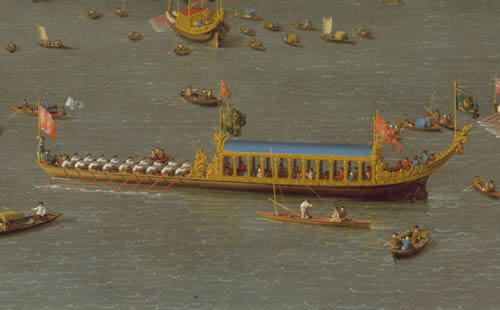
Before horse drawn coaches were introduced into England, most royal or state processions in London went by water. As the love of pageantry grew in the time of Henry VIII, so processions by water from the City of London up to Westminster or downstream to Greenwich, became part of the pattern of city life. Not only was it the more direct route, but it was also pleasanter at a time when open sewers ran through the plague-infested streets and spectators at processions were crushed against walls. Moreover, the royal residences were on the Thames, and the town houses of many of the nobility had gardens stretching down to the waterside, with their own landing stairs. The Thames was the equivalent of today’s M4 motorway and the state barges were the limousines!
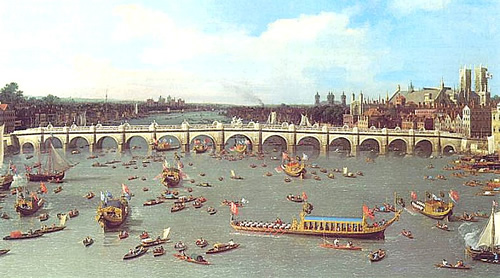
The City Livery companies were amongst those who revelled in pageantry since it asserted their importance and civic pride and the focus was Lord Mayor’s Day. The earliest account of such a procession by water is found in the records of the Brewer’s Company for 1422: ‘That William Walderne was chosen Mayor of St Edmunds Day, when it was ordered that the Aldermen and Craft should go to Westminster with him to take his charge, in barges without minstrels.’
By the 16th century the precedence of the Companies was carefully regulated. First went The Lord Mayor’s Barge, followed by the barge of his own company, to which also fell the task of staging the masque or pageant. Then followed the other companies in the traditional order: Mercers, Grocers, Drapers, Fishmongers, Goldsmiths, Skinners, Merchant Taylors, Haberdashers, Salters, Ironmongers, Vintners and Clothworkers. When royal barges were also i the procession a halt was called on the return journey and the companies’ barges lined up on either side of the river to allow the royal barges to make their way forward to the front, receiving salutes as they did so. Arguments over precedence constantly broke out!
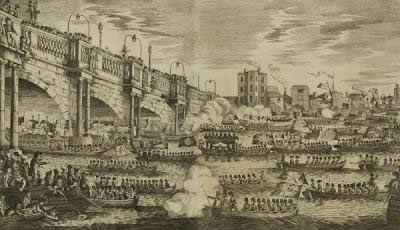
With increasing prosperity in the 17th century and more frequent public ceremonies, most of the companies acquired their own barges, and permanent decorations were painted round the whales of the vessels, and included the companies’ emblems and insignias. During the 18th century hulls became lower with flatter and straighter sheer lines and into the 18th century the canvas awnings of the house gave way to wooden roofs accessible with railings and stairways. Atop the house were colourful flags and banners and aft were seats for the musicians, who were an integral part of such festivities. From the earliest days the provision of ‘a mynstrelsie’ was the first requirement for good entertainment, and the procession would pass ‘with all its drumes and flutes and trumpettes blohying’.
Royal progresses on the Thames were fairly frequent during the Tudor period. The most elaborate was for the coronation of Henry VII’s Queen (Elizabeth of York) in 1487, ‘when she came from Greenwich attended by barges’, and in 1533 Anne Boleyn’s coronation (and in the same year the christening of the future Queen Elizabeth 1). In Grafton’s description of the water pageant on this occasion, ‘The Queene appeared in riche clothe of gold and entered into her Barge . . . musicians continually playing . . . and many Bishops and noblemen, everyone in his Barge.’
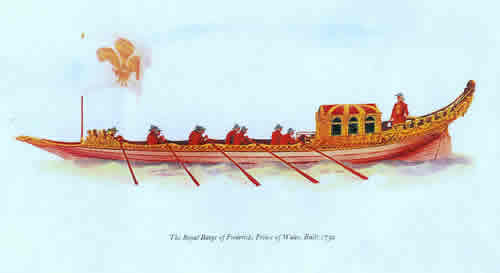
Queen Elizabeth I, on her accession to the throne in 1558 went by water to the Tower, and whenever she changed her residence, whether it was to Greenwich, Hampton Court, Windsor or Richmond, if she went by water she was attended by the Mayor and City Companies, as well as by private barge, accompanied by artillery on board and ‘a pleasant melodie of instruments’. Maybe William Shakespeare witnessed these processions, which could well have inspired his description of Cleopatra:
‘The barge she sat in like a burnished throne,
Burn’d on the water; the poop was beaten gold;
Purple the sails, and so perfumed that
The winds were love-sick with them; the oars were silver,
Which to the tune of the flutes kept stroke and made
The water which they beat to follow faster,
As amorous of their strokes . . .’’
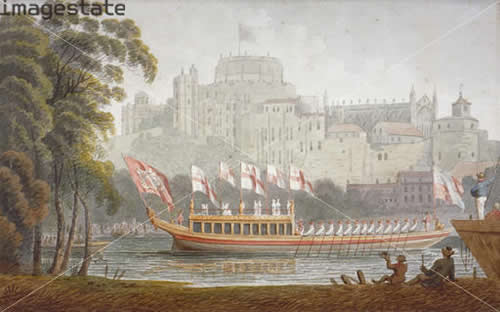
The high point of pageantry and royal and civic magnificence on the Thames came with the Stuarts. James I and his Queen brought the splendour of the continental court with them and the scale of the pageants was huge with the entertainments often lasting for days. According to one witness, ‘They took barge at Winchester stairs and rowed to Whitehall against the tide. The chief masques went in the King’s Barge royally adorned, and plenteously furnished with a great number of war lights, that they alone made a glorious show. Other gentlemen went in the Prince’s Barge, and certain other went in other fair barges. Each barge and galley being replenished with store of torchlights, made so rare and brave a show upon the water as the like was never seen upon the Thames.’
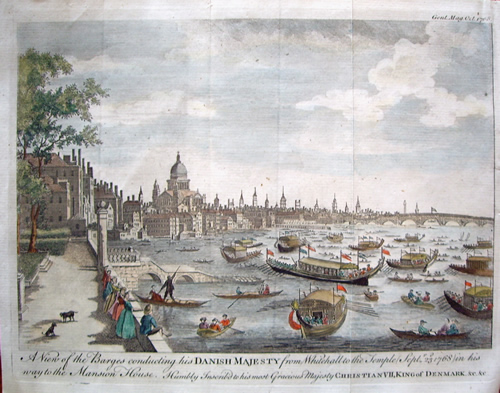
The Commonwealth put a blight on such pageantry, but ‘the most magnificent triumph that ever floated on the Thames’, according to John Evelyn, restored the tradition when Charles II on the occasion of his wedding to Catherine of Braganza in 1661, ‘came in an antique-shaped open vessel, covered with a state, or canopy, of cloth of gold, made in form of a cupola, supported with high Corinthian pillars, wreathed with flowers, festoons and garlands.’ Nevertheless, in spite of great pageants in 1714for George I’s coronation, 1733 for the reception of the Prince of Orange and 1768 for the arrival of the King of Denmark river pageants were less fashionable.
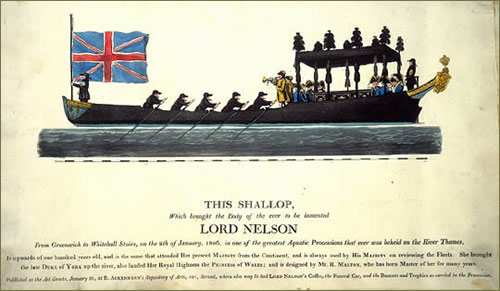
Then a splendid ceremony of a different kind took place in January 1806 when the body of Admiral Lord Nelson was brought in procession up river from Greenwich to St Paul’s Cathedral for the burial service. It was a scene of magnificence as the barges of the Admiralty, the Lord Mayor, the Livery Companies and others swept away from Greenwich, with naval craft firing minute-guns alongside the funeral barge, sombre under its black pall. The barge had been built for Charles II. The lines are simple but there is no superstructure, and it hardly ranks as a state barge. Maybe that is as it should have been be for Nelson, for it is clearly more like a ship’s boat, with which he was so familiar and in which as a teenager in the Thames itself he went ‘in the cutter and decked long-boa, which was attached to the Commanding officer’s ship at Chatham. Thus by degrees I became a good pilot, for vessels of that description, from Chatham to the Tower of London, down the Swin and the North Forland; confident of myself amongst rocks and sands, which has many times since been a great comfort to me’.
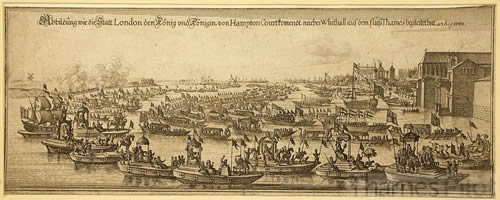
Unlike Charles II’s barge, the state and livery barges had a high or ‘lute’ stern, which helped the bargemaster to obtain a good view of the river. The bargemaster was an important personage not only in the companies but also in royal and noble households. As early as 1486 the Royal Bargemaster was protected by royal charter. His costume has varied little and it appears that the watermen were the first public servants to wear uniforms. Since the 18th century the royal bargemaster has worn a scarlet coat embellished with the royal insignia in silver braid on the front and back, kneebreeches, buckled shoes, white silk stockings, and a cocked hat. The Royal Watermen also wear scarlet, laced with gold with a gilt badge on the arm and a peaked jockey’s cap of black velvet. These uniforms are still worn today but not since 1849 did The Royal Bargemaster and the Royal Watermen under him have a Royal Barge to fulfil their duties.

The Queen’s Row Barge Gloriana has changed that. Moreover, the succession of river pageants since 2005, starting with The Emirates Thames Nelson Flotilla, and including The Tudor Pageant in 2009, Henry’s Honeymoon in 2010, The Lord Mayor’s Show in 2011, and of course the stunning Thames Diamond Jubilee Pageant and the last day of the London 2012 Olympic Torch Relay this year, have opened a new chapter in the ceremonial use of the Thames. Once again it is witness to the proud and stately occasions that delighted the hearts of our forbears.
ORGANISE AN EVENT
Thames Alive is the one-stop-shop for any organisation wishing to arrange a distinctive event on the River Thames. Meet the team »
SUPPORT YOUR RIVER
Display The Thames Alive logo. Download and use the Thames Alive logo for free now!
Download the logo »
EVENT CALENDAR
Thames Alive organises special events on the Thames and supports existing events.
View forthcoming events »
